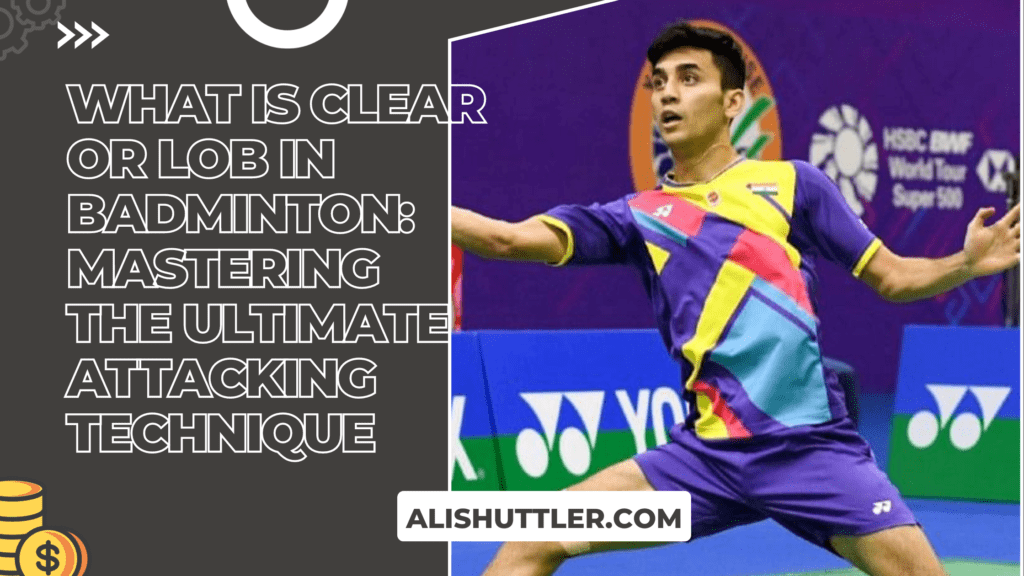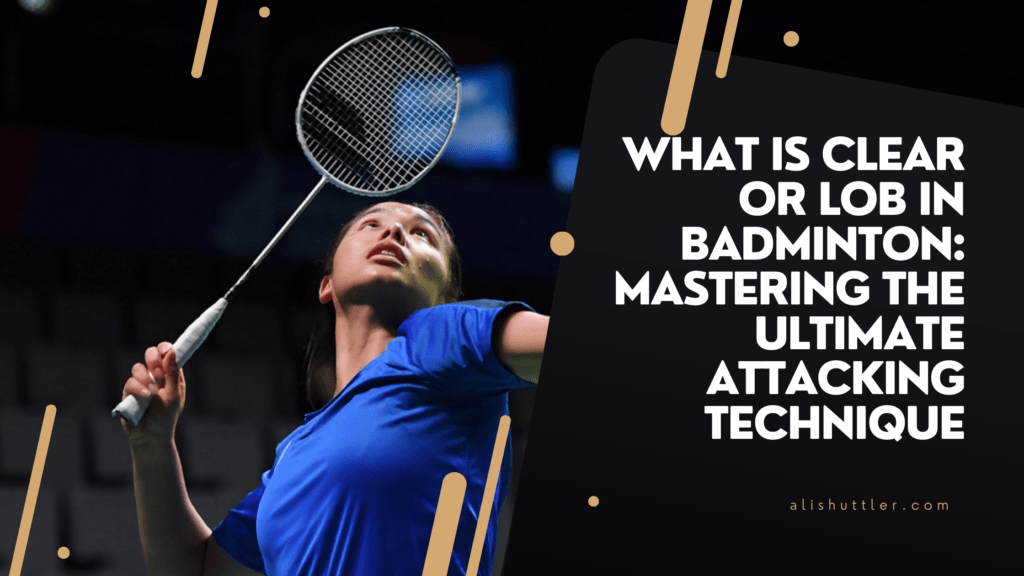Have you ever wondered how badminton players effortlessly send the shuttlecock soaring high above their opponents? It’s all thanks to two crucial techniques: clear or lob in badminton. These fundamental badminton shots play a vital role in the game, allowing players to strategically position the shuttlecock deep into their opponent’s court.
Clear shots, including the badminton jump smash and badminton smash, are executed with an overhead motion, propelling the shuttlecock high and far. Lob shots in badminton follow a more upward trajectory. Both of these shots require precision and control, making them essential skills for any player looking to dominate on the badminton court. Additionally, these skills can also be beneficial in other racket sports, like tennis.
By mastering clear and lob shots, players gain an advantage in defensive badminton, as they can effectively push their opponents towards the baseline. These shots also open up opportunities for net play and help maintain control during intense rallies.
So, whether you’re aiming for a powerful tennis stroke or executing a delicate drop shot with a racket, understanding the basics of clear and lob shots is key to elevating your badminton game. Let’s dive into these techniques further and explore how you can enhance your skills on the court.
Table of Contents
Differentiating Lob and Clear Shots: Forehand and Backhand Techniques
Forehand clear shots involve swinging the racket forward with a straight arm motion. This technique allows players to hit the shuttlecock high and deep into the opponent’s court, putting them on the defensive. To execute a forehand clear shot, position your body sideways to the net, with your non-racket foot slightly ahead for balance. Swing your racket with a straight arm, making contact with the shuttlecock at its highest point.
Backhand clear shots require a sideways swing of the racket, using wrist rotation for power. Unlike forehand clears, backhand clears are executed when the shuttlecock is on your backhand side. Stand facing the net with your feet shoulder-width apart. As you swing, rotate your torso and use your wrist to generate force for an accurate shot toward the opponent’s back line.
Forehand tennis lobs use an upward swing, while backhand lobs utilize a flicking motion. Lobs are employed when opponents are positioned close to the net or during defensive play when you need more time to recover. For forehand lobs, stand sideways to the tennis court and swing upwards in an arc motion to send the tennis ball high over your opponent’s head. On the other hand, backhand lobs involve a quick flick of the wrist combined with a backward swing to create elevation.
Understanding the differences between forehand and backhand techniques in badminton is crucial for mastering shots like clears and lobs. By developing proficiency in footwork and adapting hand movements, players can effectively execute these shots during gameplay. Whether it’s hitting powerful clears or executing strategic lobs, honing these skills will enhance your overall performance on the court in a tennis match.
Understanding the Concept of Lob Shots in Badminton
Lob shots are defensive strokes used in badminton to create distance between opponents on the court. The objective of a lob shot is to lift the shuttlecock high over the opponent’s head, forcing them to move backward. To execute effective lob shots, proper timing and technique are necessary.
In badminton, players can play lob shots with the shuttle from various positions on the court. This versatility allows players to strategically use lob shots to gain an advantage over their opponents. Whether near the net or further back on the court, a well-executed lob shot with the shuttle can disrupt an opponent’s rhythm and force them into a defensive position.

To successfully perform a badminton lob, players need to focus on their footwork and racket positioning. By using quick footwork and getting underneath the shuttlecock at the right moment, players can generate enough power and height for a successful lob shot. Maintaining control over racket angle and swing speed is crucial for accuracy and placement. The lob shot is essential in badminton as it allows players to smash the ball over the net, execute net shots, and perform lifts.
Mastering the art of badminton lobs requires practice and experience. Players must develop a sense of timing and anticipation to read their opponent’s movements accurately. By observing their opponent’s positioning and body language, players can anticipate when it’s best to utilize a lob shot as part of their strategy.
Mastering the Technique: Executing a Perfect Lob Shot
To execute a perfect lob shot in badminton, it’s crucial to focus on mastering the technique of lifts and employing the right skills. Here are some key points to consider when attempting a lob shot in badminton.
- Maintain a relaxed grip on your racket handle: When attempting a lob shot, it’s essential to have a loose grip on your racket. This allows for better control and flexibility during the stroke.
- Generate power through forearm muscles: Instead of relying solely on wrist movement, focus on using your forearm muscles to generate power for the badminton shots. This will result in a more effective and accurate smash.
- To improve control over trajectory in badminton shots, make sure to use an open-faced racket angle when hitting a lob shot. This enables you to adjust the direction and height of the shuttlecock more precisely, especially during lifts near the net.
- Practice footwork drills for positioning: Before executing a lob shot, it’s important to work on your footwork skills. By practicing drills that enhance your positioning on the court, you’ll be better prepared to execute successful lifts and shuttle shots, resulting in a higher net score.
By incorporating these techniques into your badminton game and dedicating time to practice them consistently, you can master the art of executing perfect lob shots. Remember to maintain a relaxed grip, generate power through your forearm muscles, use an open-faced racket angle, and improve your footwork for optimal results. These techniques are essential for executing lifts and shuttle shots effectively.
So why not give it a try? Start working on your lob shots today and take your badminton game to new heights with lifts, shuttle, net, and one!
Strategic Advantages of the Lob Shot in Badminton
Using a lob shot in badminton offers several strategic advantages, especially when it comes to lifting the shuttle high into the air. This technique allows players to create more time and space for themselves, as well as giving them the opportunity to net the shuttle and gain an advantageous position in the game.
- Forcing opponents into defensive positions near their baseline: The lob shot puts pressure on opponents by making them retreat towards their baseline, limiting their offensive options.
- Disrupting the opponent’s rhythm: A well-executed lob forces opponents to quickly move backward, disrupting their rhythm and making it harder for them to anticipate and respond effectively.
- Creating opportunities for follow-up attacking shots: A precisely placed lob can create openings for follow-up attacking shots, allowing players to take advantage of the opponent’s compromised position.
- Controlling the pace and tempo of the game: By strategically utilizing lob shots, players can control the pace and tempo of the game. They can slow down play when needed or use lobs as part of a fast-paced attacking strategy.
Offensive Tactics: Utilizing the Attacking Lob Shot
The attacking lob shot is a deceptive stroke used to catch opponents off guard during lifts. By disguising an attacking lob as a clear shot, players can surprise their opponents with unexpected power and placement. Attacking lobs are effective when opponents are positioned too close to the net or expecting a drop shot, making them perfect for shuttle strategies.
Mastering the technique of an attacking lob shot requires practice and precision. It involves using a combination of racket lifts, leg strength, and timing to generate power and accuracy. Here’s how players can effectively utilize this offensive tactic by utilizing shuttle lifts.
- Set up the opponent: Begin by engaging in a fast-paced rally, mixing up shots such as net shots, drops, and smashes. This will keep your opponent guessing and create an opportunity for an attacking lob.
- Aim for distance: When executing the attacking lob shot, aim to hit the shuttlecock high towards the backcourt area of your opponent’s side. This will force them to move quickly backward, giving you an advantage in dictating the pace of play.
- Use deception: To make it harder for your opponent to anticipate your move, disguise your attacking lob as a clear shot initially. This will cause them to position themselves closer to the net, leaving them vulnerable when you suddenly unleash a powerful lob.
- Timing is key: The success of an attacking lob relies on precise timing. Jump slightly before making contact with the shuttlecock to generate more power and height in your shot.
- Follow through: After executing the attacking lob, be prepared for any defensive shots from your opponent. Position yourself strategically on the court so that you can react quickly and continue putting pressure on them.
Defensive Strategies: Regaining Control with Defensive Lifts and Clears
Defensive lifts and clears are essential techniques in badminton that help players regain control of the rally when facing aggressive shots from opponents. These high, deep shots allow players to buy time and recover from difficult situations on the court, especially when dealing with the shuttle.
To execute defensive lifts effectively, proper footwork is crucial. Positioning oneself correctly ensures that the defensive lift can be executed with precision and accuracy. By using quick footwork, players can move into position to counter their opponent’s aggressive shots with a well-executed defensive lift.
When performing defensive clears, it is important to aim for areas where opponents have limited offensive options. This strategic placement forces opponents into weaker positions, making it harder for them to launch powerful attacks or return the shot effectively. By directing defensive clears strategically, players can put themselves back in control of the rally.
Defensive lifts and clears are versatile techniques that can be used in various scenarios during a badminton match. For example, when your opponent plays a powerful badminton lob, you can use a defensive lift to return the shuttle to their side of the court. On the other hand, if your opponent plays a drop shot, you can execute a defensive clear as your next shot.
- When faced with a strong attacking shot in badminton, a defensive lob can be used to send the shuttlecock high and deep into the opponent’s court, forcing them to retreat and giving the defending player time to recover.
- If an opponent plays a weak lift or makes an error near the net, a well-timed net lift with the shuttle can be utilized as a defensive strategy to regain control of the rally and set up for the next shot, such as a drop shot.
- In situations where an aggressive shot puts a player under pressure near their baseline, executing a powerful defensive lob can help reset the rally and create an opportunity for recovery.

What is clear or lob in badminton? Conclusion
In conclusion, clear and lob shots play a vital role in the game of badminton. They are essential techniques that every player should master to enhance their gameplay and strategic advantage.
Differentiating between lob and clear shots, both forehand and backhand techniques are crucial. Understanding the concept of lob shots is essential for executing a perfect shot. By mastering the technique, players can effectively utilize offensive tactics with attacking lobs or regain control through defensive lifts and clears.
The significance of the lob shot lies in its strategic advantages. It allows players to lift the shuttlecock, creating opportunities by placing it in hard-to-reach areas for their opponents. This shot can be used as an offensive weapon to surprise opponents or defensively to reset the rally.
To improve your badminton skills, it is important to consistently practice the techniques of forehand and backhand lift shots. Mastering these shots and understanding their purpose will allow you to strategically implement them during matches.
Remember, consistency is key. Keep practicing the lift shot, drop shot, and net shot techniques regularly to improve your gameplay and gain an edge over your opponents.
FAQs
Q: How do I differentiate between a lob shot and a clear shot?
The main difference between a lob shot and a clear shot lies in their trajectory. A lob shot is hit high into the air with an arcing motion to create lift, while a clear shot is hit deep towards the back boundary of the court.
Q: Can I use a forehand technique for both clearing and lobs?
Yes, you can use a forehand technique for both executing a powerful lift shot and a delicate net shot. However, it’s important to adjust your grip, swing speed, and racket angle depending on whether you want to execute a powerful lift shot or a delicate net shot.
Q: Are there any specific footwork patterns I should follow when performing clears or lobs?
Yes, proper footwork is crucial for executing effective clears, lobs, and lifts. The footwork patterns will vary depending on your position on the court and the shot you intend to play. It’s essential to practice proper footwork techniques to ensure a balanced and efficient execution of these shots, including the lift.
Q: How can I use the lob shot as an offensive tactic?
The lob shot can be used as an offensive tactic by catching your opponent off guard. By hitting a well-placed attacking lob, you can force your opponent into a defensive position, giving you an opportunity to follow up with a strong lift or drop shot.
Q: Are there any specific situations where I should use defensive lifts or clears?
Defensive lifts and clears are useful when you find yourself under pressure, trying to regain control of the rally. These shots allow you to create distance between yourself and your opponent, buying time to recover from a difficult situation or reset the rally.
Remember, practice is key to improving your badminton skills. Keep honing your technique for the lift shot and net shot, strategizing effectively, and most importantly, enjoy the game!

